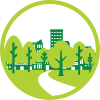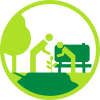Does your community want to enhance biodiversity and better manage its natural assets? This factsheet explores how thoughtful tree planting and urban forest management can restore and connect habitats to enhance urban biodiversity, ecosystem health and ecosystem structure.
 Biodiversity in the urban forest
Biodiversity in the urban forest
Trees are critical for supporting biodiversity. Tree species like white oaks, hackberries and beaked hazelnut sustain local wildlife by producing acorns, berries and nuts that feed bird and mammal species. Other trees, like eastern white cedars or eastern redbud, provide shelter for birds or produce flowers that support native pollinators. Trees also support local watersheds by preventing erosion in ravines and along rivers and improving water quality.
While individual trees provide important benefits for wildlife, it is vital to maintain and protect patches of undisturbed forests and other areas with high tree density, particularly in urban and peri-urban environments (areas located on the outskirts of cities and towns). These patches are composed of mostly native trees and other vegetation that have co-evolved and formed symbiotic relationships with native wildlife. Conserving these spaces, along with planting new trees, helps to preserve important habitat and maintain native species populations.
 Threats to urban forests
Threats to urban forests
Many communities around the world have established themselves in areas with high biodiversity. However, as cities and towns expand and land is cleared to make room for development, existing ecosystems like wetlands, forest and grasslands can be significantly altered or replaced entirely.
Today, many urban ecosystems, including urban forests, have been degraded from the impacts of development. This shows up as habitat loss, invasive species, pollution and poor soil quality. A degraded ecosystem can lead to native plant species not regenerating as they should and wildlife populations declining.
Urban forests also suffer from fragmentation. Cities and towns often contain patches of forest and other ecosystems that are isolated from one another by human-made barriers like roads, commercial buildings and housing developments. These barriers prevent wildlife from crossing between different patches which, over time, can lead to a decline in biodiversity and lower wildlife populations.
 Restoring habitat through tree planting and management
Restoring habitat through tree planting and management
Ecosystem restoration is the process of returning a degraded or converted ecosystem to a healthy, functional and sustainable state (i.e., what existed prior to human intervention). This process includes activities such as removing invasive species, planting native vegetation, remediating soil and improving water quality.
In urban and peri-urban areas, tree planting is a highly effective method for restoring habitats and conserving biodiversity. Planting trees helps re-establish canopy structures, supports wildlife, prevents invasive species and promotes native plant diversity.
Case study: Restoring the Black Oak savannah in the City of Toronto
The Black Oak savannah is a rare and diverse grassland ecosystem in Ontario that relies on fire to thrive. Periodic controlled wildfires in these ecosystems benefit native plants and animals by reducing invasive species, stimulating native plant regeneration and restoring wildlife habitat. For centuries, Indigenous communities have managed the savannah through practices like traditional burns. However, urban development and colonial practices such as fire suppression have largely destroyed or vastly changed much of the Black Oak savannah from its original state.
A large patch of Black Oak savannah still exists in several parks in the City of Toronto, including High Park. In 1995, the city determined that the trees in the park were nearing the end of their life expectancy and new trees were not regenerating to replace them. The ecosystem was not functioning optimally, and its long-term viability was at risk.
The city has since begun restoration efforts by partnering with local Indigenous communities to conduct annual traditional and prescribed burns, targeted plantings of black oak, and careful monitoring and removal of invasive species. Over time, these actions have led to natural regeneration within the ecosystem, illustrating the value of planting and careful management in ecosystem restoration.
Learn more about traditional and prescribed burns in the City of Toronto.
 Improving habitat connectivity in and out of the urban forest
Improving habitat connectivity in and out of the urban forest
Habitat connectivity is the extent to which distinct patches of habitat are connected, which can influence how or if animals and plants can travel between different habitable areas. Increasing habitat connectivity in and around urban areas can help mitigate the effects of isolated patches and improve biodiversity.
Efforts to promote biodiversity often concentrate on large natural habitats outside of urban environments. For example, the Yellowstone to Yukon Conservation Initiative is a collaborative effort to protect and connect landscapes across more than a million square kilometres in the United States and Canada. These types of projects connect large swathes of habitat through land agreements and the establishment of corridors that allow wildlife to move safely across large tracts of land.
But smaller natural urban spaces and peri-urban spaces, like municipal parks and other greenspaces, can also support considerable biodiversity, promoting species and ecosystem diversity by reducing fragmentation. Trees planted on municipal streets and in parks can create green corridors that provide temporary food and shelter for birds and pollinator species searching for higher-quality habitat. Careful analysis and planning, including mapping existing greenspaces, is crucial to identify and prioritize sites that can enhance connectivity.
Case study: City of Surrey biodiversity strategy and green infrastructure network
The City of Surrey, BC, has taken significant steps to conserve biodiversity with a dedicated municipal strategy endorsed by its council in 2014. Surrey has integrated objectives from its biodiversity conservation strategy into its official community plan, climate change action strategy and urban forest management strategy, among others, and has developed a set of design guidelines to support neighbourhood-level approaches to increasing biodiversity.
Part of this work involves the development of a green infrastructure network connecting 3,900 hectares of natural green corridors and greenspaces across the city. The network is based on three core principles:
- Preserve large core habitat areas, such as forest stands or parks (“hubs”).
- Ensure connectivity between habitat areas (“corridors”).
- Provide a diversity of habitat features throughout Surrey (“sites”).
The city uses a combination of tools to protect public and private land, including development permit requirements, parkland dedications and land acquisition.
Learn more about the City of Surrey’s biodiversity initiatives.
 Strategies for restoring urban forests and connecting habitats in your community
Strategies for restoring urban forests and connecting habitats in your community
Effective planning for biodiversity in and around municipalities is increasingly important as urban areas expand. Good planning can help achieve conservation goals and support the ecosystem functions and services on which our communities depend.
Municipalities can leverage various tools to protect and restore urban forests and to ensure habitat connectivity. Below are initial strategies that your municipality can explore to plant new trees and to manage existing treed spaces in a way that promotes biodiversity.
Identify and assess areas that need to be restored and connected
Creating an inventory is an important first step to determine ideal locations for restoring and connecting habitat. Your inventory should include municipal parks and other public or privately-owned land that can support additional tree planting. Inventories can be created through a combination of on-the-ground searches, existing public park information, satellite imagery and community engagement. They can be stored and visualized using tools like geographic information system (GIS) software or iTree (for more details on these, review our factsheet on urban forestry technology and tools).
After creating your inventory, analyze potential sites based on factors like proximity to an existing natural area, size of existing greenspace, existing biodiversity and presence of invasive or at-risk species. Biodiversity assessments can be performed on sites with existing natural greenspaces like woodlots or ravine areas by trained biologists, foresters or ecologists.
You can also use your inventory to determine opportunities to improve connectivity between existing greenspaces. The distance between two existing parks or greenspaces or the presence of existing green corridors (e.g., streets with continuous canopy or vegetation cover) nearby are measures that can help prioritize locations for connectivity.
Key resource: The San Francisco Estuary Institute’s Making Nature’s City Toolkit outlines possible assessment criteria for evaluating urban biodiversity. It includes information about the size, shape and distance between patches of greenspace, width of corridors, habitat diversity, presence of native vegetation and more.
Implement tree planting and other restoration projects
After conducting your parks and plantable spaces inventory, you can begin plans to maintain or enhance biodiversity in your community. The outcomes of your inventory assessment will inform which sites you prioritize to plant new trees, create green corridors and otherwise support habitat restoration and connectivity.
Always seek expert advice when planning new projects. Your team should include experienced biologists, Knowledge Keepers, ecologists or foresters with ecosystem restoration and connectivity knowledge. Wherever possible, use native trees and vegetation to better support native pollinators and make sure to select species that can tolerate future climate conditions (e.g., drought-tolerant species or species not currently threatened by pests or diseases). When prioritizing sites, consider projects that would improve or create critical habitat for species at risk.
After restoration work is complete, it is important to have a long-term monitoring plan for the site. Invasive species are a constant threat to natural spaces and are easiest to remove when found early.
Consider how your community can be involved in data collection, monitoring and restoration efforts. Community members, naturalist groups and other local environmental organizations are often aware of natural spaces in need of restoration activities like tree planting or invasive species removal. Ensuring community members are aware of and able to participate in the planting and restoration projects can increase their impact and success. Involve local Indigenous communities by seeking guidance from Knowledge Keepers and prioritizing input from Indigenous leaders and community members during engagement.
You can also plan events to encourage community members to record and share wildlife sightings in public databases. For example, municipalities and other community groups can participate in Nature Conservancy Canada’s annual Big Backyard BioBlitz.
Protect existing natural spaces through local policies and planning
The easiest way to protect biodiversity in your community is to protect existing natural spaces. Restoring former natural areas is often more costly and work intensive than maintaining existing spaces. Municipalities can explore options to create protected areas on municipal land and partner with other landowners and/or orders of government to establish protections.
To maintain your existing natural spaces, you can create a biodiversity strategy or plan. Municipal biodiversity strategies are comprehensive long-term plans to protect and enhance local natural spaces. They provide an outline your municipality can follow to increase biodiversity and stop important habitat loss.
Ensure municipal development plans and land use policies are prioritizing the protection and enhancement of local biodiversity. Consider the different tools at your disposal, such as zoning or development permit bylaws, that can be used to protect existing natural areas and enhance biodiversity.
Key resource: The Green Bylaws Toolkit is a comprehensive resource for land use planners and decision-makers that explains how to create bylaws and other policy tools that protect and enhance the natural environment and green infrastructure.
 Other municipal examples
Other municipal examples
- The City of Nicolet, QC, collaborated with Habitat to assess ecological connectivity in the region and create an action plan for developing an ecological corridor. This included activities like tree planting and wetland preservation.
- The City of Victoria, BC, has listed improving ecological connectivity as a dedicated outcome in its urban forest master plan. Strategies include using tree planting and management to connect larger natural areas and provide corridors for wildlife.
- The City of Edmonton, AB, uses an ecological network approach to conserve its natural areas. A natural connections strategic plan and a natural area systems policy outline specific principles, roles and responsibilities for implementation.
- The City of Toronto, ON, released a biodiversity strategy to enhance the quality and quantity of biodiversity and increase awareness of nature in Toronto. This has included numerous restoration projects and public engagement initiatives, such as biodiversity booklets for different groups of species (e.g., Trees, Shrubs and Vines of Toronto).
 Next steps
Next steps
- ICLEI Canada, biodiverCITIES: A handbook for municipal biodiversity planning and management
- C40 Cities, How to enhance, restore and protect biodiversity in your city
- Park People, Rewilding the city: solutions for urban biodiversity [webinar recording]
- DeepRoot Blog, Urban biodiversity: the future of conservation
- Nature Canada, Municipal protected areas
- Nature Canada, Nature-based solutions for urban areas and communities
- University of British Columbia, SEEDS knowledge exchange: ecological connectivity toolkit (under “Research mobilization toolkits”)
- Miistakis Institute for the Rockies, Municipal eco-toolkit: tools for maintaining your natural systems
This resource was created in partnership by Tree Canada and FCM’s Green Municipal Fund for the Growing Canada’s Community Canopies initiative, which is delivered by the Federation of Canadian Municipalities and funded by the Government of Canada.

